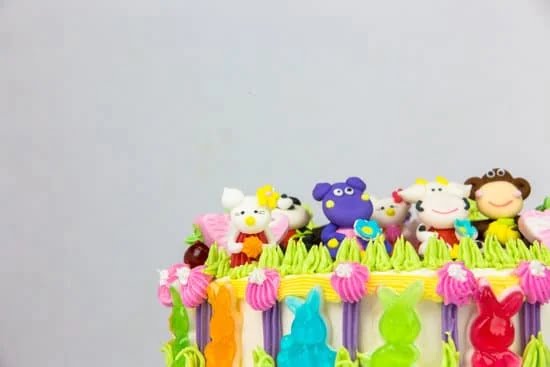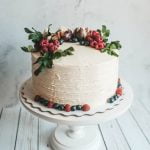Chocolate cake decorations add the perfect finishing touch to any dessert, transforming a simple cake into a work of art. Whether you’re a professional baker or just a home cook looking to impress, mastering the art of chocolate cake decorations will take your baking skills to the next level.
In this article, we will explore the different types of chocolate that can be used for cake decoration, the essential tools and equipment you’ll need, and various techniques for creating stunning designs.
From simple dipping and drizzling techniques to advanced piping and sculpting methods, you’ll learn how to create intricate designs that will wow your guests. We’ll also discuss how to incorporate other ingredients such as nuts, fruits, and edible flowers for added delight. If you’ve ever wanted to elevate your dessert game, chocolate cake decorations are the way to go.
Chocolate is not only delicious but also versatile when it comes to decorating cakes. With its smooth texture and rich flavor, it can be melted down into a variety of shapes and sizes. From simple shavings and curls to elaborate molds and sculptures, there’s no limit to what you can create with chocolate.
In order to achieve the best results, it’s important to choose the right type of chocolate for your desired effect. We’ll explore different options such as dark chocolate, milk chocolate, white chocolate, and even colored chocolates that can be used for decoration purposes.
To successfully execute chocolate cake decorations, having the right tools and equipment is essential. From molds and piping bags to spatulas and paint brushes, these tools will help you achieve precise designs with ease. We’ll discuss the must-have supplies that every aspiring cake decorator should have in their kitchen arsenal.
Before diving into the various techniques for decorating with chocolate, it’s important to know how to prepare it properly. The process of melting, tempering, and cooling chocolate can greatly affect its appearance and texture on the finished cake. We’ll provide step-by-step instructions on how to achieve the perfect consistency and shine for your chocolate decorations.
Whether you’re a novice or an experienced decorator, this article will provide you with the knowledge and skills needed to create stunning chocolate cake decorations. From simple techniques like dipping and drizzling to advanced methods like piping and sculpting, you’ll be able to elevate your desserts to a whole new level. So grab your apron and get ready to indulge in the art of chocolate cake decorations.
Types of Chocolate for Cake Decoration
When it comes to chocolate cake decorations, choosing the right type of chocolate is crucial. The type of chocolate you use can greatly impact the taste, texture, and appearance of your decorations. There are several different types of chocolate that are commonly used for cake decoration, each with its own unique characteristics.
One popular option for chocolate cake decorations is dark chocolate. Dark chocolate has a rich and intense flavor that pairs well with a variety of cake flavors. It also has a higher cocoa content, which gives it a smooth and creamy texture when melted. Dark chocolate can be easily shaped and molded into intricate designs, making it perfect for creating intricate decorations.
Another option to consider is milk chocolate. Milk chocolate has a sweeter flavor and a creamier texture compared to dark chocolate. It is also more malleable when melted, making it easier to work with for certain decoration techniques such as drizzling or piping. Milk chocolate is often preferred by those with a sweeter tooth and can add a touch of indulgence to any dessert.
For those who prefer a lighter and less intense flavor, white chocolate is an excellent choice for cake decorations. While technically not true “chocolate” since it does not contain cocoa solids, white chocolate adds an elegant touch to cakes with its creamy and sweet taste. It can be easily melted and poured over cakes or used in combination with dark or milk chocolates for creating contrast in colors and flavors.
When it comes to selecting the best type of chocolate for your cake decorations, personal preference plays a major role. Experimenting with different types of chocolates can help you discover what works best for your desired taste and design. Whether you choose dark, milk, or white chocolate, the key is to select high-quality options that will elevate your desserts to new heights.
| Type of Chocolate | Characteristics |
|---|---|
| Dark Chocolate | – Rich and intense flavor
|
| Milk Chocolate | – Sweeter flavor and creamier texture
|
| White Chocolate | – Creamy and sweet taste
|
Tools and Equipment Needed for Chocolate Cake Decorations
When it comes to chocolate cake decorations, having the right tools and equipment is essential for achieving professional-looking results. From basic utensils to specialized gadgets, here are some of the essential supplies you’ll need to have on hand:
Offset Spatula
An offset spatula is a must-have tool for spreading icing or ganache evenly over the surface of your cake. Its angled design allows for better control and precision while working.
Piping Bags and Tips
Piping bags are used for creating decorative patterns, borders, and writing on cakes. Look for reusable bags made of cloth or silicone, as they are more durable and eco-friendly. Additionally, a variety of piping tips in different shapes and sizes will give you endless options when it comes to creative designs.
Cake Smoother/Viva Paper Towels
For achieving a smooth finish on your cakes, a cake smoother is indispensable. It helps in ensuring that the icing is evenly distributed and free from any imperfections. If you don’t have a cake smoother, Viva paper towels can also be used by gently pressing them against the surface of the cake to smooth out any bumps or unevenness.
Mold/Stencil Set
If you’re looking to create intricate designs on your chocolate cake decorations, investing in a mold or stencil set is worth considering. These sets come in various shapes and patterns, making it easier to achieve professional-looking results without much effort.
Palette Knife
A palette knife is another handy tool that can be used for spreading ganache or buttercream icing onto your cake. Its long blade allows for even application with minimal mess.
In addition to these basic tools, there are also other equipment that may come in handy such as an electric mixer for whipping up frosting quickly, an adjustable turntable for easy cake rotation during decoration, and a heat-resistant spatula or scraper for smoothing melted chocolate. With these essential tools and equipment, you’ll be well-equipped to embark on your chocolate cake decoration journey.
Preparing the Chocolate for Decoration
Melting chocolate is a crucial step in preparing it for cake decoration. There are several methods you can use to melt chocolate, depending on your preference and the tools you have available. One popular method is using a double boiler, which involves placing chopped chocolate in a heatproof bowl set over a pan of simmering water. Stir the chocolate constantly until it melts and becomes smooth.
Another method is using the microwave, which can be quicker and more convenient. Place the chopped chocolate in a microwave-safe bowl and heat it on low power in short intervals, stirring after each interval until melted. Be careful not to overheat the chocolate or it may scorch.
Once the chocolate is melted, the next step is tempering it to ensure it has a shiny appearance and stays firm at room temperature. Tempering involves reheating the melted chocolate to specific temperatures while stirring continuously. A common tempering technique is called seeding, where pieces of unmelted chocolate are added to the melted chocolate and stirred until they dissolve, bringing down the temperature of the overall mixture.
After tempering, it’s important to let the chocolate cool slightly before using it for decoration. This allows it to thicken slightly and become more manageable for various techniques. You can speed up cooling by transferring the melted and tempered chocolate to a clean piping bag or squeeze bottle with a small opening. Squeezing out small amounts of chocolate onto parchment paper or a silicone mat will expose more surface area, aiding in quicker cooling.
In summary, preparing chocolate for decoration involves melting it using methods like double boiling or microwaving, tempering it to achieve shine and stability, and allowing it to cool slightly before use. These steps are essential for achieving professional-looking results with your cake decorations.
Simple Chocolate Cake Decoration Techniques
When it comes to decorating a chocolate cake, there are numerous techniques that can be used to create beautiful and delicious designs. In this section, we will explore three simple yet effective chocolate cake decoration techniques: dipping, drizzling, and shaving.
One of the easiest ways to add an elegant touch to a chocolate cake is by dipping it in melted chocolate. This technique involves fully or partially immersing the cake or specific elements of the cake into melted chocolate.
The most common method is to dip the bottom of the cake into the melted chocolate and allowing it to set before serving. Alternatively, you can also dip fruits, nuts, or other confectionery items in melted chocolate and place them strategically on top of the cake for an eye-catching display.
Another popular technique for decorating a chocolate cake is drizzling. Drizzling involves pouring a thin stream of melted chocolate over the cake in various patterns or designs. To achieve neat lines and designs, you can use a piping bag with a small round tip, or simply use a spoon for a more organic look. Drizzling can be done in multiple layers using different colored chocolates for an added visual appeal.
Shaving is another simple yet effective technique that adds texture and elegance to a chocolate cake. By using a vegetable peeler or cheese grater, you can create artistic shavings from solid bars of chocolates and garnish around the edges or on top of the cake. This method not only adds visual appeal but also enhances the taste and texture by adding bits of rich chocolate goodness.
To ensure success with these simple chocolate cake decoration techniques, it is important to use high-quality chocolates that are suitable for melting. Additionally, practicing proper melting methods such as double boiling or using a microwave at low power will help achieve smooth results.
For those who want to take their decorating skills to the next level, the next section will explore advanced chocolate cake decoration techniques such as piping, molding, and sculpting. But first, let’s master these basic techniques and create stunning chocolate cake decorations with just a few simple steps.
| Decoration Technique | Description |
|---|---|
| Dipping | Fully or partially immersing a cake or specific elements in melted chocolate |
| Drizzling | Pouring thin streams of melted chocolate over the cake to create patterns or designs |
| Shaving | Creating artistic shavings from solid bars of chocolate and garnishing the cake |
Advanced Chocolate Cake Decoration Techniques
When it comes to creating truly impressive chocolate cake decorations, advanced techniques such as piping, molding, and sculpting can take your creations to the next level. These methods allow for intricate designs and unique shapes that will wow your guests. In this section, we will explore how to master these advanced chocolate cake decoration techniques.
Piping: Piping is a technique that involves using a pastry bag with a small tip to create intricate designs on the surface of the cake. To pipe with chocolate, you’ll need to use tempered chocolate that has been cooled slightly but is still fluid enough to flow through the pastry bag.
Begin by filling the pastry bag with melted chocolate and gently apply pressure to create lines and shapes on the cake. You can practice piping on a piece of parchment paper before attempting it directly on the cake.
Molding: Molding is an advanced technique that involves creating three-dimensional shapes using molds. There are silicone molds available in various shapes and sizes specifically designed for chocolate work. To mold chocolate, start by melting tempered chocolate until smooth and pourable. Carefully pour the melted chocolate into the molds, making sure not to overfill them. Allow the chocolate to set completely before removing it from the molds.
Sculpting: Sculpting with chocolate allows you to create unique and custom designs that can truly showcase your creativity. This technique requires working with cooled and firm tempered chocolate that can be manipulated into different shapes. To sculpt with chocolate, start by warming up a small piece in your hands until it becomes pliable.
Shape it into your desired form using tools like toothpicks or small knives. Be patient as you work since manipulating the chocolate too quickly may cause it to crack or lose its shape.
With proper practice and patience, you can master these advanced techniques and create stunning chocolate cake decorations that will amaze your guests. Remember to start with simple designs and gradually progress to more intricate ones as you gain experience. Don’t be afraid to experiment and let your creativity flow when working with chocolate. And most importantly, have fun.
Creating Intricate Designs
When it comes to creating intricate designs on chocolate cakes, using stencils, transfers, and melted chocolate can take your cake decorations to the next level. These techniques allow you to achieve professional-looking designs with relatively little effort. Here are some tips and ideas to help you get started:
- Using Stencils: Stencils are a great tool for creating intricate designs on your chocolate cake. They come in a variety of shapes and patterns, allowing you to create anything from delicate lacework to bold geometric designs. To use a stencil, simply place it on top of your cake and spread melted chocolate over it using a spatula or an offset spatula. Carefully remove the stencil and let the chocolate set before adding any additional decorations.
- Transferring Designs: Another way to achieve intricate designs is by using transfers. These are pre-made chocolate designs that can be easily applied to your cake. Transfers can be purchased at specialty baking stores or made at home using acetate sheets and melted chocolate.
To use a transfer, simply place it on top of your cake while the chocolate is still wet, gently pressing it down to adhere it. Once the chocolate has set completely, carefully peel off the acetate sheet to reveal the design. - Melted Chocolate Decorations: Melted chocolate can also be used to create freehand designs on your cake. By piping melted chocolate onto parchment paper or acetate sheets in various shapes and patterns, you can create unique decorations that will stand out on your cake. Once the chocolate has hardened, carefully peel off the parchment paper or acetate sheet and place the decoration onto your cake.
Incorporating intricate designs onto your chocolate cake can elevate its appearance from simple to stunning. Whether you choose to use stencils for precise patterns or experiment with transfers and melted chocolate for more creative designs, these techniques will help you achieve professional-looking decorations with ease. With a little practice and creativity, you’ll be able to wow your friends and family with beautifully decorated chocolate cakes every time.
Incorporating Other Ingredients
When it comes to chocolate cake decorations, the possibilities are endless. One way to take your cake to the next level is by incorporating other ingredients such as nuts, fruits, and edible flowers. Not only do these add a pop of color and texture, but they also provide additional flavor and visual appeal to your masterpiece.
- Nuts: Nuts are a classic addition to chocolate cakes. They not only enhance the taste but also add a satisfying crunch to every bite. Some popular nuts used in cake decorations include almonds, walnuts, pecans, and hazelnuts. You can use them in various ways – sprinkle chopped nuts on top of your cake as a garnish or press them into the sides for an elegant look.
- Fruits: Fresh fruits can bring a burst of freshness and natural sweetness to your chocolate cake decorations. Strawberries, raspberries, blueberries, and sliced kiwi are excellent choices that complement the rich flavor of chocolate. Consider arranging them in attractive patterns on top of your cake or even layering them between cake layers for added taste and visual appeal.
- Edible Flowers: Edible flowers not only add beauty but also a touch of sophistication to your chocolate cakes. Some commonly used edible flowers include roses, pansies, violets, marigolds, and lavender blooms. Before using any flower in your cake decoration process make sure it is safe for consumption and has been grown organically without the use of any harmful pesticides or chemicals.
Remember to always carefully wash and dry any fruits or flowers before using them in your decorations. Additionally, ensure that you choose ingredients that pair well with chocolate flavors so that they don’t overpower or clash with the overall taste profile of the cake.
By incorporating nuts, fruits, and edible flowers into your chocolate cake decorations, you can create stunning visual displays that are as delicious as they are beautiful. The combination of textures, flavors, and colors will impress your guests and elevate your cake to a whole new level. Experiment with different combinations and arrangements to find the perfect mix for your desired aesthetic and taste.
Troubleshooting Common Issues
When it comes to chocolate cake decorations, it’s not uncommon to encounter a few common issues along the way. Whether you’re a seasoned baker or just starting out, it’s important to know how to troubleshoot these problems in order to achieve the best results possible. In this section, we will explore three common issues that may arise during the chocolate cake decoration process: cracks, blobs, and excessive melting.
Cracks
One of the most frustrating issues that can occur when decorating a chocolate cake is the appearance of cracks on the surface of the chocolate. Cracks can be caused by various factors, such as improper cooling or rapid temperature changes. To avoid this problem, it is essential to properly prepare your chocolate before decorating.
To prevent cracks from forming, ensure that your melted chocolate is cooled at room temperature before applying it to your cake. This will allow the chocolate to solidify evenly and avoid any sudden temperature changes that can lead to cracking. Additionally, make sure that your cake is completely cooled before adding any decorations. The moisture from a warm cake can cause the chocolate to expand and contract, resulting in unsightly cracks.
Blobs
Another common issue when working with chocolate for cake decorations is the formation of blobs or uneven shapes. This can happen when too much melted chocolate is applied at once or if it is not spread evenly across the surface. However, there are a few simple tricks you can use to fix this problem.
To prevent blobs from forming when adding melted chocolate decorations, start by using smaller amounts and gradually build up as needed. This will help ensure that you have better control over where the chocolate goes and prevent an excess amount from accumulating in one spot. Additionally, use a small offset spatula or a toothpick to spread out and shape the melted chocolate as desired.
Excessive Melting
Excessive melting is another issue that can occur when working with chocolate cake decorations. This often happens when the environment is too warm, causing the chocolate to melt faster than desired. To avoid this problem, it is important to consider the temperature and conditions in your kitchen.
If you find that your chocolate is melting too quickly, try working in a cooler area of your kitchen or using a fan to circulate air and create a cooler environment. You can also refrigerate or freeze your chocolate decorations for a short period before applying them to the cake. This will help firm up the chocolate and reduce the risk of excessive melting.
By troubleshooting these common issues of cracks, blobs, and excessive melting, you’ll be well on your way to creating stunning chocolate cake decorations. Remember, practice makes perfect, so don’t be discouraged if you encounter these problems initially. With time and experience, you’ll become more skilled at troubleshooting and achieving flawless chocolate cake decorations that are sure to impress.
Final Tips and Tricks for Stunning Chocolate Cake Decorations
Experiment with Different Flavors
When it comes to chocolate cake decorations, don’t be afraid to think outside the box and experiment with different flavors. While the classic combination of chocolate and vanilla is always a crowd pleaser, there are many other flavor profiles you can explore. Consider adding a hint of coffee or almond to your chocolate decorations for a rich and decadent twist.
You can also try incorporating spices like cinnamon or chili powder for a unique and unexpected flavor experience. Don’t be afraid to get creative and let your taste buds guide you.
Play with Colors
One way to take your chocolate cake decorations to the next level is by playing with colors. While traditional chocolate decorations are brown, you can easily add pops of vibrant color to make your cakes stand out. For example, you can use colored candy melts or food coloring to create beautifully tinted chocolates in various shades.
This allows you to match the theme or color scheme of any occasion, whether it’s pastel hues for a baby shower or bold, bright colors for a birthday party. Remember that a little goes a long way when it comes to coloring chocolates, so start with small amounts and gradually add more until you achieve your desired shade.
Embrace Texture
Texture can greatly enhance the visual appeal of your chocolate cake decorations. Consider adding different textures such as crushed nuts, cookie crumbs, or sprinkles to create contrast and interest. You can press these ingredients onto the melted chocolate while it is still soft, or sprinkle them on top once the chocolate has hardened slightly.
Another way to add texture is by using different molds or embossing tools to create intricate patterns on your chocolates. Don’t be afraid to get creative and experiment with various textured elements to add depth and dimension.
By following these final tips and tricks, you’ll be well on your way to creating stunning chocolate cake decorations. Remember to have fun with the process and let your creativity shine through. Whether you’re a beginner or an experienced baker, these techniques will help you elevate your desserts and impress your guests. So go ahead, grab some chocolate and let your imagination run wild.
Conclusion
In conclusion, mastering the art of chocolate cake decorations can elevate any dessert to a whole new level of sophistication and visual appeal. With the right techniques, tools, and ingredients, you can create impressive designs that will leave your guests in awe.
Throughout this article, we have explored various aspects of chocolate cake decorations, from choosing the best type of chocolate to preparing it for decoration. We have also discussed simple and advanced techniques, as well as tips for creating intricate designs using stencils, transfers, and melted chocolate. Additionally, we explored incorporating other ingredients such as nuts, fruits, and edible flowers to add even more delight to your creations.
While it is normal to encounter some common issues when working with chocolate, such as cracks or excessive melting, we provided troubleshooting tips to help you overcome them. By following these guidelines and practicing your skills, you will become increasingly adept at creating stunning chocolate cake decorations.
Remember that practice makes perfect when it comes to mastering any art form. Don’t be discouraged if your first attempts don’t turn out exactly as you envisioned – keep experimenting and refining your techniques. With time and perseverance, you will be able to create breathtaking chocolate cake decorations that will impress not only your taste buds but also anyone who lays eyes on them.
So go ahead and unleash your creativity in the kitchen. With the knowledge gained from this article and your passion for delicious desserts, you are well on your way to becoming a master of chocolate cake decoration. Enjoy the process and savor each moment as you bring joy and delight to yourself and those lucky enough to indulge in your edible works of art.
Frequently Asked Questions
What can I use to decorate a chocolate cake?
There are several options you can use to decorate a chocolate cake and add a touch of creativity and elegance to its appearance. One popular option is to use chocolate shavings or curls, which can be made by using a vegetable peeler on a block of chocolate. Another idea is to dust the cake with cocoa powder or powdered sugar, which adds a simple yet visually appealing touch.
For those who prefer a more elaborate decoration, chocolate ganache can be used as both an icing and a decorative element. It can be poured over the cake or piped onto the surface in various patterns, creating beautiful designs.
How to make chocolate garnishes for cakes?
Making chocolate garnishes for cakes is not as difficult as it may seem, and it adds an impressive finishing touch to any dessert. One technique involves melting chocolate and spreading it thinly on a flat surface, such as a baking sheet lined with parchment paper. Once the chocolate has cooled slightly but is still pliable, you can use cookie cutters in different shapes (such as hearts or stars) to cut out pieces of the hardened chocolate.
These shapes can then be placed strategically on top of your cake for an elegant garnish. Alternatively, you can pipe melted chocolate onto wax paper in various designs and let it harden before carefully peeling it off and placing it on your cake.
How to decorate a cake with just chocolate?
Decorating a cake with just chocolate opens up endless possibilities for creativity. One simple yet effective method is using melted chocolate to create intricate designs directly on the surface of the cake. This can be done using either a piping bag or by drizzling the melted chocolate from a spoon in freehand style.
You can create swirls, zigzags, or even write messages depending on your artistic abilities. Another approach is using molded chocolates or truffles as decorative elements – these can be arranged around the edges or placed strategically on top of the cake for an elegant presentation. Additionally, you could incorporate grated or finely chopped chocolate into the cake’s frosting for a rich and textured decoration.

Welcome to our cake decorating blog! My name is Destiny Flores, and I am the proud owner of a cake decorating business named Cake Karma. Our mission is to provide delicious, beautiful cakes for all occasions. We specialize in creating custom cakes that are tailored specifically to each customer’s individual needs and tastes.





